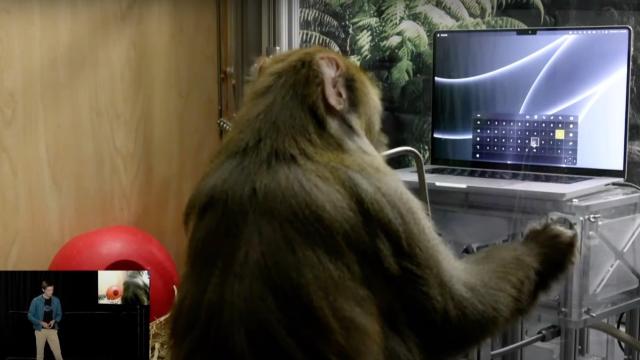Elon Musk kicked off a highly anticipated “show and tell” event for Neuralink, his brain computer interface company, this week with a warning: “I’m going to be a little bit repetitive.”
Musk stayed true to his word, spending the next minutes rehashing many of his same talking points about the dangers of general artificial intelligence and heralding the praises of Neuralink’s past technical demos. While the company did show off some new iterative testing examples and announced it’s “about six months” away from inserting one of its devices into a human, the mountain the company needs to climb to realise its vision of creating real world cyborgs appears as steep as it did a year prior.
Neuralink’s overall goal, according to Musk, is to create a generative input and output device capable of interfacing with any part of a user’s brain. In the short term, Musk believes this tech can help people with disabilities regain some motor control or potentially even restore vision. In the long term, as Musk made emphatically clear during the presentation, Neuralink’s goal is to integrate with humans to radically increase efficiency and stay relevant in an age of supercomputing artificial intelligence. Neuralink, in the end, wants to be a cyborg company. On stage, Musk hinted he may even opt to drill a Neuralink device into his own skull in a future demo.
“I could have a Neuralink device implanted right now and you wouldn’t even know, hypothetically,” Musk teased.
Last year, Neuralink released a widely viewed video claiming to show one of its test monkeys playing a game of Pong using only its mind. The company followed that up this week with a sequel of sorts. In this case, Musk showed a video of a monkey using a digital mouse and keyboard to type out letters. It was revealed that the words “welcome to show and tell” floating on the presentation stage were actually typed out by the monkey. Musk called this, “telegraphic typing.”
That sounds impressive until you start breaking it down. For starters, Neuralink clearly didn’t teach the test monkey how to type or understand human language. Rather, engineers taught the monkey how to move a cursor over to specific keys on a keyboard engineers highlighted. Though still impressive, it’s worth pointing out researchers first taught a human to move a rudimentary cursor with their brain nearly two decades ago in 2006. Other competing brain interfaces companies like Synchron, meanwhile, have already beaten Neuralink to human trials.
“These are incremental advances,” University of Pennsylvania neurosurgeon and neuroscientist Daniel Yoshor said in an interview with The New York Times. “The hardware is impressive but does not represent a dramatic advance in restoring or enhancing brain function.”

Neuralink’s next major step forward, as it was last year, remains obtaining FDA approval to begin testing in humans. Musk said his company had finished most of the necessary paperwork and expected to clear that regulatory hurdle in around six months. Even if that prediction turns out to be true though, it means Neuralink will have failed to meet its previous prediction of having devices in human heads by 2022. Prior to that, Musk said he expected human trials could begin by 2020. In other words, we’ve been here before.
“Obviously, we want to be extremely careful and certain that it will work well before putting a device in a human,” Musk said.
Musk also also skirted past addressing allegations of abuse and harm occurring in its animal testing facilities. An animal rights group is currently trying to pressure Neuralink into releasing nearly 400 photos of test monkeys they claim were tortured and abused during testing for the brain device. That same organisation released a legal complaint alleging Neuralink-equipped monkeys suffered extreme exhaustion and vomiting stemming from the devices. The complaints, which Neuralink has publicly pushed back against, claim 15 monkeys died at the company’s UC Davis test facility between 2017 and 2020. Neuralink engineers at the event, meanwhile, said they successfully implanted into the visual cortex of two monkeys.
“Our monkeys are pretty happy,” Musk said between chuckles during the event. “We are not cavalier about putting devices in animals.”
Neuralink’s lacklustre presentation comes as Musk continues to deal with the fallout of his chaotic Twitter acquisition. Though Musk and Neuralink helped progress brain interface tech and brought in waves of new investor capital, others are quickly racing to close the gap. Just this month, Neuralink’s co-founder and former president Max Hodak emerged from the shadows with his rival company which aspires to create a similar interfaces device but without the need for physical surgery. That company, called Science Corp, has reportedly already raised $US160 ($222) million in funding.
